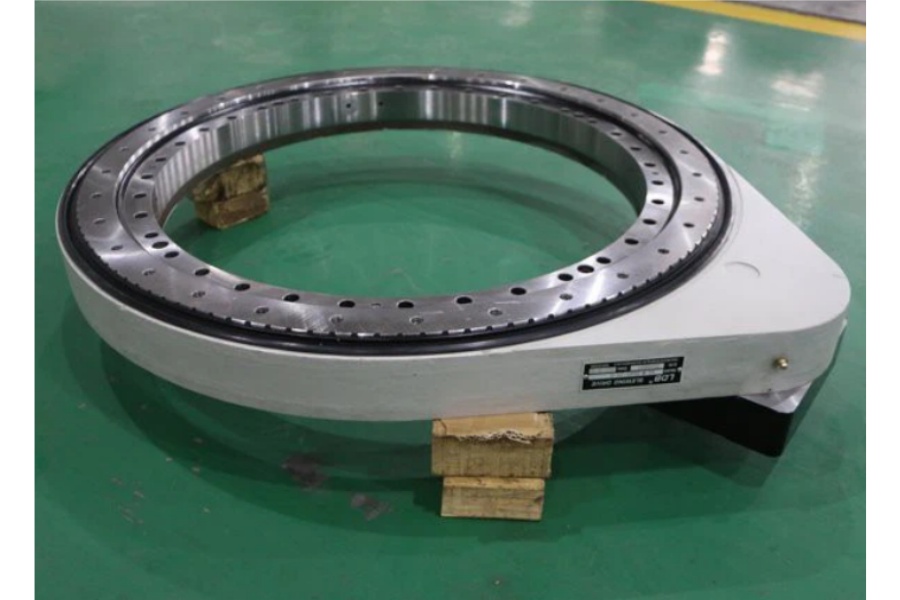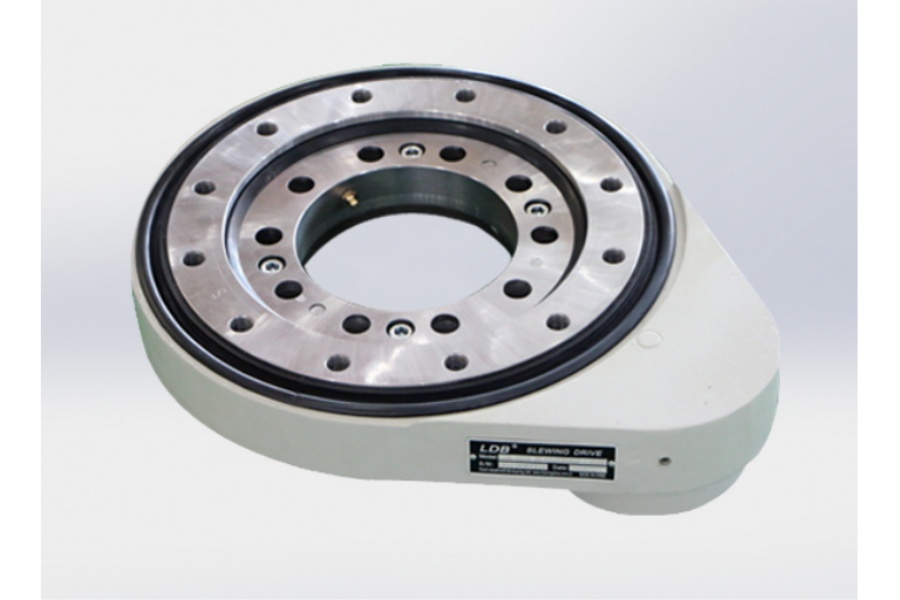Slewing Bearing for Aerial Work Platform
In the world of construction, maintenance, and logistics, Aerial Work Platforms (AWPs) – including scissor lifts, boom lifts, and telehandlers – are indispensable for enabling work at height. The safety, stability, and smooth operation of these machines hinge on a critical, often overlooked component: the Slewing Bearing. This specialized bearing is the pivotal heart that allows for the precise and controlled rotation of the platform. At LDB Bearing, we engineer and manufacture slewing bearings that meet the extreme demands of the AWP industry, ensuring operator safety and maximum uptime.
This comprehensive guide delves into everything you need to know about slewing bearings for aerial work platforms, from their fundamental role to selection, maintenance, and why LDB is your trusted manufacturing partner.
What is a Slewing Bearing for an Aerial Work Platform?
A Slewing Bearing for an Aerial Work Platform is a large-diameter, low-profile rotational bearing that connects the machine’s upper structure (the boom and platform) to its lower chassis or turntable. It serves as the fundamental pivot point, enabling 360-degree continuous or limited rotation.
Unlike standard bearings that handle primarily radial or axial loads, a slewing bearing for an AWP is uniquely designed to withstand combined loads. This includes the axial load (the weight of the boom, platform, operators, and tools), the radial load (side forces during movement and wind), and, most critically, the tilting moment – the powerful overturning force generated when the boom is fully extended. Its robust design and integrated gear (for driven rotation) make it a key enabler of the machine’s functionality and reach.
Key Characteristics of a High-Performance AWP Slewing Bearing
Slewing bearings for AWPs are not standard industrial bearings; they are purpose-built for this demanding application with specific features:
- Compact Cross-Section: AWPs require a low profile to maintain a low center of gravity and a compact machine design. The bearing must deliver high load capacity within a minimal height envelope.
- High Load Capacity and Rigidity: Safety is paramount. The bearing must have exceptionally high static load ratings, especially for tilting moments, to prevent catastrophic failure under maximum load and extension.
- Integrated Gear: Most AWP slewing bearings feature a precision-machined internal or external gear that meshes with a pinion gear from the drive motor, enabling powered rotation.
- Smooth Operation and Low Torque: For precise platform positioning and smooth start-stop motion, the bearing must have low and consistent rotational torque.
- Robust Sealing: AWPs operate in harsh environments filled with dust, moisture, and debris. Multi-lip, wear-resistant seals are essential to protect the raceway and retain lubricant, ensuring long service life.
- High Safety Factor: AWP bearings are designed with a high static safety factor (fₛ), typically well above standard industrial minimums, to account for dynamic shock loads, uneven surfaces, and unexpected forces.
Primary Applications in Aerial Work Platforms
Slewing bearings are the rotational core of various AWP types:
- Articulating Boom Lifts: Enable the rotation of the upper arm and platform, allowing the operator to reach over and around obstacles.
- Telescopic Boom Lifts: Facilitate the 360-degree rotation of the entire boom assembly for extensive horizontal reach.
- Scissor Lifts: Used in larger models to allow the entire platform to rotate, increasing work area coverage without moving the base.
- Telehandlers: Provide the rotation function for the load arm, enabling precise placement of materials.
- Spider Lifts and Specialized AWPs: Offer the compact yet powerful rotation needed for complex access scenarios.
How Does a Slewing Bearing Work in an AWP?
The working principle involves a harmonious interplay between structure and mechanics:
- Load Transmission: The weight and forces from the platform and extended boom are transferred into the upper ring of the slewing bearing.
- Load Distribution: These combined loads are distributed through the rolling elements (balls or rollers) positioned in the raceway. The specific geometry of the raceway allows a single-row ball bearing (four-point contact) to efficiently handle axial, radial, and moment loads simultaneously.
- Driven Rotation: The rotation drive motor engages its pinion gear with the integrated gear on the bearing. As the pinion turns, it drives the entire upper structure of the AWP (and the upper bearing ring) to rotate relative to the stationary lower chassis.
- Structural Integration: The bearing is bolted directly to the machine’s chassis and upper structure via pre-drilled holes, creating a rigid, integral unit that safely transfers all operational loads.
How to Select the Right Slewing Bearing for Your AWP Design
Selecting the correct bearing is a critical engineering decision that dictates machine safety and performance. Partner with LDB’s engineers to analyze:
- Load Calculations: The most crucial step. Determine the maximum:
- Axial Load (Fa): Total dead weight on the platform.
- Radial Load (Fr): Side forces from wind and dynamic movement.
- Tilting Moment (M): The primary load, calculated based on the maximum boom extension and load capacity.
- Required Safety Factor (fₛ): Establish a minimum static safety factor based on industry standards (e.g., ANSI/SAIA A92.22) and your internal safety protocols. A factor of 1.5 or higher is common.
- Bearing Type and Size:
- Type: Single-row four-point contact ball bearings are most common due to their excellent load versatility and compact design. For heavier-duty models, double-row ball or crossed roller bearings may be considered.
- Size: Determine the required bore and outer diameter based on structural constraints. The cross-section height is a key limiting factor.
- Gearing and Drive Compatibility: Specify internal or external gearing, gear module, and quality to ensure perfect meshing with your drive pinion and smooth power transmission.
- Sealing and Lubrication: Define the sealing system (e.g., triple-lip seals for dusty sites) and the lubrication plan, including fitting types and positions for easy maintenance.
The LDB Bearing Ordering Process: Simple and Collaborative
We make procuring reliable AWP slewing bearings straightforward:
- Initial Inquiry: Contact us via our website or email with your machine model or preliminary load data.
- Technical Collaboration: Our engineering team will work with you to finalize load calculations, select the optimal bearing model, and provide a detailed CAD drawing for your approval.
- Quotation and Lead Time: You will receive a formal quotation with pricing, lead time, and terms. We offer both standard and custom-engineered solutions.
- Manufacturing and Quality Control: Your order enters our production line, undergoing strict quality checks at every stage—from material certification to final gear inspection.
- Delivery and Support: We pack bearings securely for shipping and deliver globally. Our technical support remains available to assist with installation and beyond.
Installation Best Practices for AWP Slewing Bearings
Proper installation is vital for performance and longevity.
- Surface Preparation: Ensure the mounting surfaces on the chassis and upper structure are clean, flat, and free of burrs or paint. Any imperfection can distort the bearing rings.
- Handling: Use lifting lugs (if provided) and never lift the bearing by its seals or with slings through the bore.
- Bolting Procedure: Use only the specified high-strength bolts. Clean threads and apply a recommended thread-locker. Tighten bolts in a star-pattern sequence to the specified torque in several stages to ensure even clamping and prevent ring distortion.
- Gear Meshing Check: After installation, check the backlash and alignment between the slewing ring gear and the drive pinion, adjusting as per the machine manual.
Routine Maintenance for Long-Term Reliability
Proactive maintenance prevents unexpected downtime.
- Regular Lubrication: Follow the manufacturer’s schedule for relubricating the raceway. Use a high-quality, extreme-pressure (EP) grease. Purge old grease until clean grease emerges from the seal lips.
- Bolt Preload Check: Re-torque the mounting bolts after the first 50-100 hours of operation and periodically thereafter (e.g., every 500-1000 hours) as specified in the manual.
- Visual Inspection: Regularly check for damage to seals, grease leaks, or visible cracks in the bearing or structure.
- Operational Monitoring: Be alert to any changes like increased noise, vibration, or jerky rotation, which could indicate internal damage or contamination.
LDB Bearing: Your Professional Slewing Bearing Partner for Aerial Work Platforms
Choosing LDB Bearing means partnering with a specialist dedicated to the highest standards of safety and performance.
- Deep Industry Expertise: We understand the unique dynamics and safety-critical nature of AWP applications.
- Custom-Engineered Solutions: We don’t just sell standard parts; we design bearings to meet your specific load, size, and performance requirements.
- Uncompromising Quality: Our bearings are manufactured from superior materials, undergo rigorous heat treatment, and are subject to 100% quality control.
- Global Support: We serve AWP manufacturers worldwide with reliable products and responsive technical support.
Engineer with Confidence. Build with Safety.
When the stability of your aerial work platform depends on its pivotal component, trust the engineering excellence of LDB Bearing. Contact us today to discuss your project requirements and receive a technical consultation.



